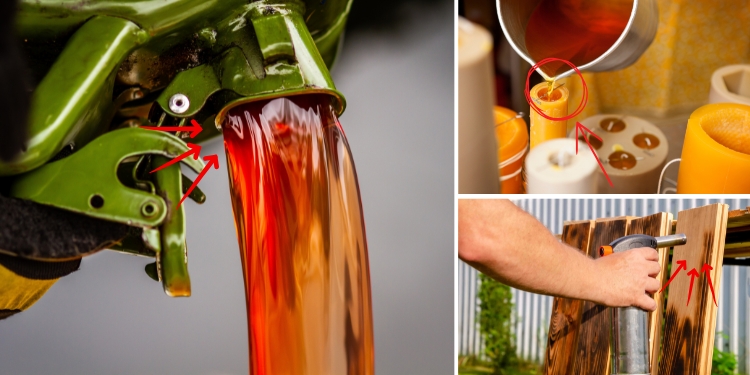10 Forgotten Fuels You Can Still Use Today

Today, when most people think of fuels, they instantly picture electricity, gasoline, diesel, or natural gas. But long before the grid took over, humans relied on a wide range of alternative fuels. We’ve forgotten many of these—or pushed them aside in favor of convenience—even though they remain easily accessible to resourceful preppers.
With that in mind, here are 10 forgotten fuels you can still use today. Some might already be hiding in your pantry, backyard, or garage.
Charcoal
What we today call “Lump” charcoal is one of humanity’s oldest fuels and remains an efficient, portable source of heat and energy. It burns hotter than wood, produces less smoke, and stores well for years when kept dry.
In many parts of the world, charcoal is still a primary cooking fuel. You can store it in a waterproof container for years, and it will still burn.
It’s pretty easy to make yourself, by simply heating dried wood in a semi-sealed vessel with the limited presence of oxygen. I used to do it every weekend when burning the brush from some old down oak trees. You can even build your backyard charcoal kiln from a 55-gallon drum.
Animal Tallow & Lard
 Long before the world became dependent on petroleum, people used animal fat and tallow for light and heat. Rendered tallow or lard can be used in oil lamps or even as emergency candles. You can even use it as high-energy cooking fuel when you’re out of modern oils.
Long before the world became dependent on petroleum, people used animal fat and tallow for light and heat. Rendered tallow or lard can be used in oil lamps or even as emergency candles. You can even use it as high-energy cooking fuel when you’re out of modern oils.
My grandfather used to render tallow and lard from every animal he butchered. Then kept it in coffee cans and sealed drums deep in the root cellar. Ideally, you want to store it in sealed containers in a cool, dark place to maximize the shelf life.
The Amish, also, still rely on tallow and lard for lighting and heating in many communities, especially where electricity is banned by their Ordnung.
It’s a quiet reminder that some of the most reliable fuels have been with us for centuries and don’t require a single volt of power. You can learn more about it by reading The Amish Ways Book (click here to get one of the last copies available)!
Used Cooking Oil
Restaurants toss out gallons of used cooking oil every day. With a little know-how and the right equipment, this seemingly useless cooking can be converted into biodiesel. It can then be used directly in modified diesel engines.
I used to know an old survivalist who came to town at the crack of dawn every Wednesday in his modified International Harvester diesel pickup truck. Then he’d siphon the decanted oil off the top of the restaurant barrels before the waste disposal service came through town on Wednesday afternoon.
Cottonseed Oil
For over a century, people across the southern U.S. commonly used cottonseed oil as a biofuel. They extracted it from cotton seeds and burned it in oil lamps. With the right equipment and know-how, you can also process cottonseed oil into biodiesel.
This plant-based fuel offers decent energy content and frequently powered homes in rural areas where cotton farming thrived.
Wood Gas
Syngas, known more commonly as “Wood Gas,” is a combustible gas produced by heating wood or biomass in a low-oxygen environment. When petroleum was in short supply during World War Two, many people in rural areas of Europe modified their cars to run on wood gas.
Today, you can still build a wood gasifier to power small engines, generators, or cookstoves.
I’ve done this as a science project for a high school chemistry class.
There was a pretty serious fireball the first time, but I managed to figure out how to do it in a controlled manner. If I can figure it out at 17, at the expense of all my arm hair, anyone can do it.
Just keep in mind — if you’re planning to rely on any small engine post-collapse, make sure it’s protected against EMP.
A single solar flare or high-altitude detonation could fry unshielded electronics in seconds. That’s why Faraday bags or EMP shields like this EMP Cloth are no longer optional for prepping.
👉 Click here to get the EMP Cloth + 2 FREE Bonuses, including the complete guide on What You Need to Have Ready Before an EMP!
Distilled Alcohol
Distilled alcohols like ethanol and methanol can be used in alcohol stoves or modified engines. Ethanol is also a common disinfectant and sterilizer, making it doubly useful in survival situations. You can make it from fermentable plant materials such as corn, malted grain, sugar cane, or fruit.
Yes, you could even create your own moonshine. Not that I’m advocating that. However, in a survival situation, you could ferment fruit peels and waste grain, then use the undrinkable “Heads” at the start and “Tails” at the end as a fuel source.
Of course, distilling anything — alcohol, water, even essential oils — takes fuel, time, and clean input. In a survival scenario, having an independent water source is even more important than fuel. That’s why you should invest in solutions like The Water Freedom System, which can extract drinking water from thin air, using simple condensation technology.

The method is so effective that it has been adopted on the toughest frontlines around the world by armies such as the U.S., U.K., France, Israel, Mexico, and India. If you’re looking for an efficient way to get water, this is as good as it gets. Click here and see how you can set up the system right in your own household!
Dung Manure Bricks
As unglamorous as it sounds, dried animal dung is one of the most common fuels in the history of man. It was one of the main fuels for the Native Americans and pioneers of the Great Plains. Even today, in rural parts of India and Africa, cow dung and horse manure are dried into bricks and burned for heat and cooking. It’s slow-burning, renewable, and requires no fancy tech.
Corn Cobs
Subsistence farm families in mid-latitude areas used to burn dried corn cobs, stalks, and other ag byproducts for cooking and heating. Dried husks ignite easily and can be used to start fires, while cobs burn hot and create embers that last longer than you might think. Most old-fashioned wood stoves and mass heaters can run on this kind of dried biomass.
Beeswax
 Beeswax isn’t just for candles and balms; it’s also a forgotten but powerful fuel that burns slowly and cleanly. It also creates a pleasant natural aroma that my beekeeper Uncle Donald always had in his house.
Beeswax isn’t just for candles and balms; it’s also a forgotten but powerful fuel that burns slowly and cleanly. It also creates a pleasant natural aroma that my beekeeper Uncle Donald always had in his house.
Before paraffin took over in the industrial age, beeswax candles lit the homes of the wealthy and the sacred spaces of churches for good reason. Beeswax burns longer and gives off very little soot.
It can be molded or dipped to create candles. It can be used as a fire starter when combined with dryer lint or sawdust. When kept warm enough to stay in a semi-liquid state, beeswax can even be used in oil lamps or soaked onto survival torches
Pine Resin Fatwood
Pine resin is a natural fire accelerant found in the roots and heartwood of pine trees. Known as “fatwood” or “lighter knot,” it lights quickly and burns hot, even when wet. Look for dead pine stumps or injured trees, where the resin collects. It’s easier to extract in the spring when the trees are warming up on one of the first hot days. If you can suddenly smell pine in the air, the resin is softening up and will be easier to extract.
Why Forgotten Fuels Still Matter
In a world increasingly vulnerable to energy disruptions from natural disasters, supply chain problems, and economic instability, knowing how to source alternative fuels just makes sense.
Keeping things like charcoal and beeswax on hand, and knowing how to do things like process cottonseed or cooking oil into diesel will give you flexibility, independence, and resilience.
Worried about your tap water? This backpack-sized water generator pulls up to 50 gallons of clean drinking water from thin air—no grid needed. Trusted by thousands of Americans, this compact powerhouse that is perfect for off-grid living, emergency preparedness, or daily use when clean water isn’t guaranteed.
You may also like:

Cheap Methods To Store Fuels
Build This Nuclear Shelter For Under $400 And Finish It In Less Than A Week, All By Yourself (Video)
The Only Fuel I Stockpile For Survival (And Why You Should Stockpile It Too)
These Fuel Storage Mistakes Could Kill You
Read the full article here









